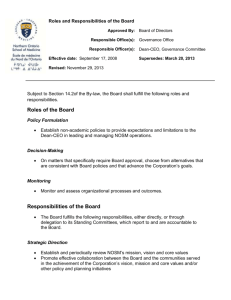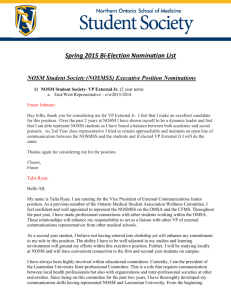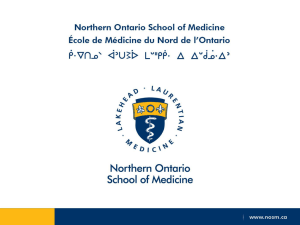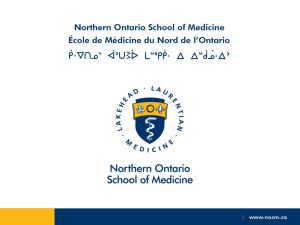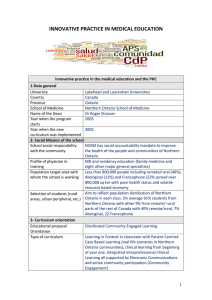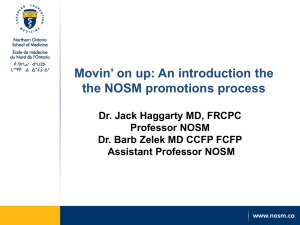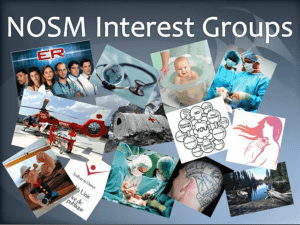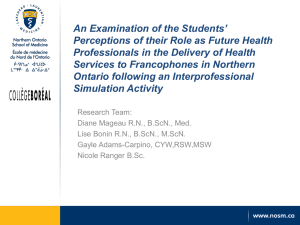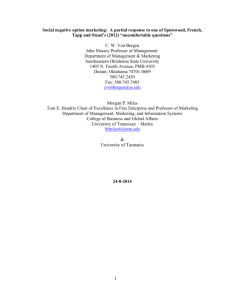Document 13053177
advertisement
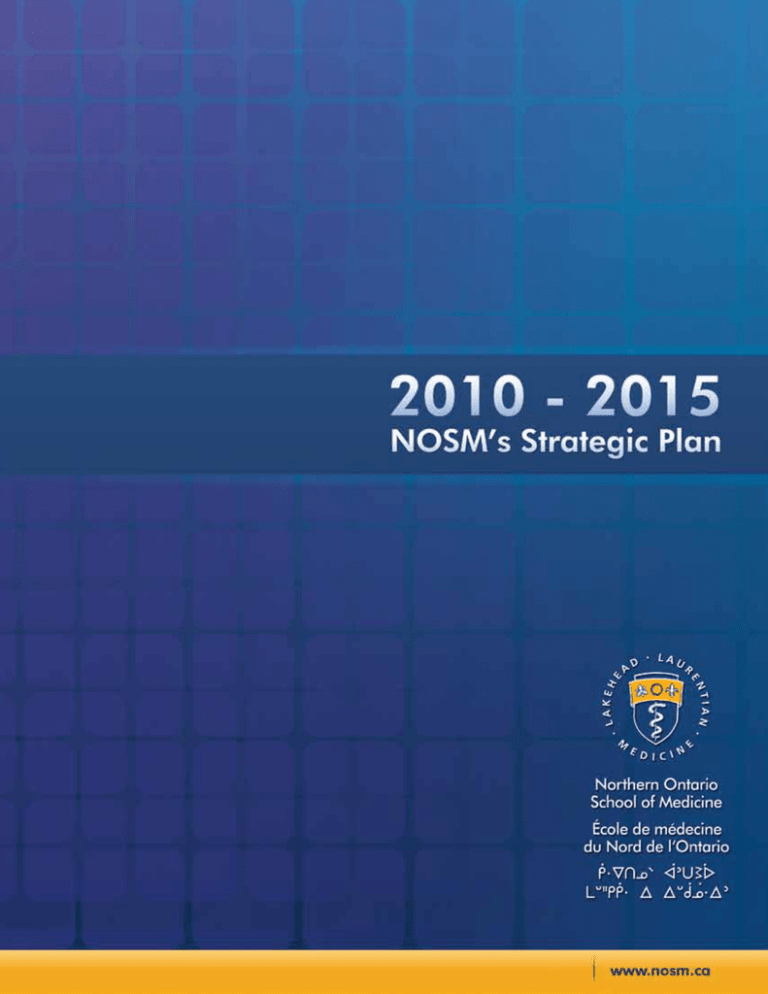
2010-2015 Strategic Plan 1 Message from the Board Chair This strategic plan marks an important point of transition for the Northern Ontario School of Medicine (NOSM). Since its official opening in 2005, NOSM has made great strides in establishing itself as a leader in distributed medical and health professional education. The next evolutionary phase will build on this success, positioning NOSM to be a leader both nationally and internationally as an innovator in distributed, learner-centred, community-engaged education and research. With our new Vision, Innovative Education and Research for a Healthier North, NOSM is committing to a focus not only on its own advances in education and research, but on pushing those advances to improve the broader population health of the North. We will achieve this by investments in our mandate, collaborations with partners, and continued engagement of our communities. In this second strategic plan, NOSM will continue to enhance its mandate of education, strengthen the focus on achieving research excellence, and further reinforce a sustainable foundation of people, operations and technology from which to advance and grow. NOSM will continue to work to develop a learning environment that values and supports a life-long commitment to its learners, faculty, staff and administration. Further, we will strive toward excellence in our relationships with, and support for, all faculty – full-time, part-time and stipendiary. Staying true to NOSM’s social accountability mandate, we will continue to emphasize a collaborative, community-engaged model that draws on the strengths and capabilities of all NOSM’s partners. This strategic plan represents the work of a large number of dedicated and enthusiastic NOSM stakeholders who have invested their time and energy into charting the medical school’s future. On behalf of the NOSM Board of Directors, I extend my deep appreciation to all the individuals and organizations who invested their time to assist us in this important strategic planning initiative. I especially note the members of the Strategic Planning Steering and the Quality Monitoring Committees, who provided guidance and support throughout the plan’s development, working tirelessly to ensure that the new strategic plan represents the voice of the entire NOSM community. I am confident that the vision, mission, values and strategic priorities established by this strategic plan will help to position NOSM for continued growth and success over the next 3-5 years. Frederick F. Gilbert, PhD Board Chair Board of Directors Northern Ontario School of Medicine 2 Vision Innovative Education and Research for a Healthier North. Mission The Northern Ontario School of Medicine (NOSM) is committed to the education of high quality physicians and health professionals, and to international recognition as a leader in distributed, learning-centred, community-engaged education and research. NOSM will accomplish this by: Being socially accountable to the needs and the diversity of the populations of Northern Ontario Actively involving Aboriginal, Francophone, remote, rural and underserviced communities Leading and conducting research activities that positively impact the health of those living in Northern communities Fostering a positive learning environment for learners, faculty and staff Achieving an integrated, collaborative approach to education, learning, and programming Increasing the number of physicians and health professionals with the leadership, knowledge and skills to practice in Northern Ontario. 3 Values Innovation The Northern Ontario School of Medicine (NOSM) encourages ingenuity, creativity, a culture of inquiry and discovery, and the importance of learning from others in every aspect of the School’s education, research, social accountability, and corporate mandates. NOSM uses innovative approaches to ensure continuous improvement of our distributed model of education and research. Social Accountability NOSM adheres to the World Health Organization’s (WHO) definition of the Social Accountability of Medical Schools as “the obligation to direct their education, research and service activities towards addressing the priority health concerns of the community, region and the nation that they have a mandate to serve. The priority health concerns are to be identified jointly by governments, health care organizations, health professionals and the public.” As part of its social accountability mandate, NOSM has the responsibility to engage stakeholders at all levels of its broad community. Collaboration NOSM pursues education and research goals in close partnership with its host universities. Collaboration and partnership is also important to NOSM with its teaching hospitals, community physicians, health professional clinical teachers, health system stakeholders, and communities it serves. NOSM values the insights, contributions, and support of its many partners that work to improve the health of the people and communities of Northern Ontario. NOSM recognizes that collaboration is both a process and outcome that engages different perspectives to better understand complex problems, and leads to the development of integrative solutions that could not be accomplished by any single person or organization. Inclusiveness NOSM fosters inclusiveness by supporting an environment which embraces differences in staff, faculty and learners and respectfully creates value from the differences of all members of the NOSM community, in order to leverage talent and foster both individual and organizational excellence. Respect NOSM’s faculty, staff, and learners seek to learn and listen to one another respectfully and communicate openly. NOSM’s staff, faculty, and learners treat others and their ideas in a manner that conveys respect as differences are discussed, fosters an open academic debate, and which respects academic freedom. 4 Table of Contents Message from the Board Chair 2 Introduction: Strategic Plan 2010-2015 6 Strategic Plan 2010-2015 8 Strategic Priority A: Enhance NOSM’s Education Program 10 Strategic Priority B: Strengthen NOSM’s Research Initiatives 11 Strategic Priority C: Develop NOSM’s Learning Environment 12 Strategic Priority D: Foster Excellent Faculty Relations 13 Strategic Priority E: Enhance Collaboration and Communication with Our Community Partners 14 Strategic Enablers 15 Moving Forward 16 Strategic Plan 2010-2015 17 Appendix B: Groups Invited to Contribute to the Development of the Strategic Plan 18 5 Introduction: Strategic Plan 2010-2015 The Northern Ontario School of Medicine (NOSM) serves as the Faculty of Medicine of Lakehead University, Thunder Bay and Faculty of Medicine of Laurentian University, Sudbury. NOSM has come a long way in a relatively short time. Since its official opening in 2005, NOSM has: developed and delivered Distributed Community Engaged Learning as its distinctive model of medical education and health research; achieved accreditation for its MD program, multiple residency programs, Continuing Education Professional Development (CEPD), and the Northern Ontario Dietetic Internship Program (NODIP); focused research attention on the health issues in Northern Ontario through annual Northern Health Research Conferences and the Partnership Opportunities in Research Gathering; graduated emergency physicians, family physicians and dietitians from its programs; and seen the charter class graduate from the MD program and move on to residencies in a range of specialties, predominantly northern or rural family medicine. There is a real sense that NOSM is fulfilling its social accountability mandate to contribute to improving the health of people and communities in Northern Ontario. The School was successful in recruiting world-class research scientists to be faculty members in the Medical and Human Sciences. More than 900 physicians and other healthcare providers have joined NOSM as faculty members in the Clinical Sciences including physicians who have moved to Northern Ontario to be involved in the School. State-of-the-art medical school buildings were constructed on time and on budget at both campuses. These buildings feature high technology smart classrooms, flexible teaching laboratories, health sciences libraries and research laboratories, as well as meeting rooms and office space. Developed through a consultative process, the holistic cohesive curriculum for the MD program is grounded in Northern Ontario and relies heavily on electronic communications to support Distributed Community Engaged Learning. In the classroom and in clinical settings, learners explore cases from the perspective of physicians in Northern Ontario. Clinical education takes place in over 70 communities and many different health service settings, so that the learners experience the diversity of communities and cultures in Northern Ontario. Following a successful accreditation site visit in March 2004, NOSM achieved preliminary accreditation in June 2004. There were subsequent accreditation visits in March and September 2005, and in the Septembers of 2006, 2007 and 2008. Full Accreditation was confirmed in February 2009 by the Liaison Committee on Medical Education (LCME) and the Committee on Accreditation of Canadian Medical Schools (CACMS). Graduating its first class of medical students in June 2009, NOSM has achieved significant success during its start-up phase. All of NOSM’s first class of undergraduate medical students were successfully matched to Canadian residency programs on their first attempt, making NOSM the only Canadian medical school in which all students were matched in the first round. In addition, the aggregate score of the charter class members in the Medical Council of Canada part one exam placed NOSM as number six of 17 Canadian medical schools. NOSM intends to build on this success as it transitions out of the start-up phase toward sustainable, continuing growth and development. In May 2009, NOSM commenced a Strategic Planning Initiative with the goal of developing a five year strategic plan (“the Plan”) that will help NOSM clearly define its future directions and focus. NOSM will begin implementation of the plan in July 2010 that will direct NOSM’s planning activities through to June 2015. The development of the Plan was overseen by an appointed Strategic Planning Steering Committee (SPSC) that represented the diverse groups of internal and external stakeholders that make up the NOSM community.1 SPSC members devoted significant effort through participation in meetings and planning activities throughout the year. 1 6 For a complete list of the SPSC membership, refer to Appendix A. The School’s letters patent and by-laws provide a frame of reference and context that govern all of the identified priorities and strategies. In line with its social accountability mandate, the Strategic Plan 2010-2015 was developed on the premise that the opinions and thoughts from the greater NOSM community should inform NOSM’s future strategic directions. This approach helps to ensure that NOSM remains true to the needs and requirements of the communities it serves. These opinions and insights were gathered from a large number of both internal NOSM stakeholders and external stakeholders across the broad health care and medical education systems.2 Internal stakeholders included NOSM learners, faculty, staff, researchers, senior leadership and Board. External stakeholders included the provincial government, community and municipal representatives, community physicians, host universities, and other medical schools across Canada. In addition to the core stakeholder input activities, a key component of this planning initiative was the completion of an external environmental scan that identified broad trends in medical education and the health care sector, and reviewed the strategic planning documents from 12 medical schools, both Canadian and international, to identify key strategic directions and opportunities that other medical schools were acting on. These findings were used to guide strategic planning discussions with the SPSC and to help evaluate the key priorities for inclusion in NOSM’s Strategic plan. The success of this Strategic Planning Initiative can only be attributed to the enthusiasm and commitment of the entire NOSM community, as well as our partners at other medical schools who volunteered their time to provide guidance. This Plan represents a shared outlook for the future of the Northern Ontario School of Medicine, and will be implemented with the continued support and participation of our broad community. 2 For a complete list of the groups that were consulted during this planning initiative, refer to Appendix B. 7 Strategic Plan 2010-2015 The strategic plan was developed to align and support the new Vision and Mission statements that were identified as part of this strategic planning initiative, as illustrated in the diagram below. The five vertical pillars represent the Strategic Priorities that have been identified as part of this planning process and represent NOSM’s focus over the next five years. Across all of our Strategic Priorities, a core set of renewed Values will permeate all of the activities and planning of NOSM, and will guide how we strive toward innovation and continue to actively engage our communities through our continued commitment to social accountability. Critical to NOSM’s new strategies are its continued relationships with its host universities, Lakehead University and Laurentian University, which will be strategic partners foundational to the achievement of this Strategic Plan. The five Strategic Priorities will enable NOSM to strengthen its distributed, learning-centred, community-engaged approach to education and research. They are: A. B. C. D. E. Enhance NOSM’s Education Program Strengthen NOSM’s Research Initiatives Develop NOSM’s Learning Environment Foster Excellent Faculty Relations Enhance Collaboration and Communication with Community Partners Vision Innovative Education and Research for a Healthier North Mission The Northern Ontario School of Medicine (NOSM) is committed to the education of high quality physicians and health professionals, and to international recognition as a leader in distributed, learning-centred, community-engaged education and research. Values Strategic Enablers Community Engagement and Communication Faculty Learning Environment Research Education Innovation, Social Accountability, Collaboration, Inclusiveness, Respect Human Resources, Informatics and Information Technology, Streamlined Operations, Diversified Revenues 8 This Strategic Planning Initiative also identified four key Strategic Enablers that are considered critical success factors for the achievement of our new Vision, Mission and Strategic Priorities. These Enablers will contribute to ensuring the ongoing sustainability of the NOSM model, and that NOSM is able to meet the goals associated with its new strategic plan. The four Strategic Enablers are: 1. 2. 3. 4. Establish a comprehensive human resources plan Explore, partner, and invest in informatics and technologies Continuously improve operational processes, infrastructure and systems Increase and diversify NOSM’s revenue streams The following sections of the strategic plan present the NOSM Strategic Priorities, Strategies, and Strategic Enablers that have been identified to support our new Vision and Mission. In support of the strategic plan, NOSM is also developing key measures of success for each strategy, which will be developed as the School embarks on the establishment of a balanced scorecard to measure ongoing performance and success of the organization. 9 Strategic Priority A: Enhance NOSM’s Education Program Given current health care trends toward Interprofessional Education (IPE) and Integrated Clinical Learning (ICL), NOSM will ensure that its curriculum is aligned to support new and innovative approaches to the delivery of classroom and clinical education. This focus will enable NOSM graduates to easily integrate into community care settings where interprofessional care models are team-based in fostering collaborative patient-centred approaches. Overall Goal Expand NOSM’s distributed education and learning model and ensure the ongoing inclusion and balance of Integrated Interprofessional Clinical Learning throughout NOSM’s undergraduate, post graduate, and health professional programs. Strategy #1: Expand the distributed community engaged learning model to all of NOSM’s education programming for health professionals to meet the needs of our learners and communities, integrating the expertise that Aboriginal and Francophone peoples bring. Strategy #2: Increase NOSM’s application of the Integrated Interprofessional Clinical Learning model of education to enable learners to practice in intra- and interprofessional models of education and care. Strategy #3: Augment broader Integrated Interprofessional Clinical Learning programming resources and expertise by collaborating with other universities and organizations to educate/train health professionals outside of NOSM to meet health human resources needs in Northern Ontario. Strategy #4: Lead the adoption of new models of education and learning with external accrediting bodies to increase the focus on community-based learning. 10 Planned Timing 2012/13 Planned Timing 2012/13 Planned Timing 2014/15 Planned Timing 2011/12 Strategic Priority B: Strengthen NOSM’s Research Initiatives Stakeholders identified research as a key area of improvement for NOSM, recognizing that research is a critical element of its academic mandate and future success. NOSM will focus on further developing its research agenda, linked to the ongoing development of its distributed education model, to continue to broaden the academic experience of its learners, faculty and staff. Taking into consideration the relative size of NOSM’s research infrastructure compared to other faculties of medicine, a focused approach to research will be adopted. As NOSM’s research initiatives are strengthened, research and planning activities conducted will reflect the need for appropriate ethical consideration, and will respect the unique cultural attributes of NOSM’s Aboriginal, Francophone and other communities. Overall Goal Define a clear strategic direction for NOSM’s research efforts, conduct research aligned to its vision and mission, and increase the number of learners, staff and full-time, part-time and stipendiary faculty participating in focused research activities. Strategy #1: Define and invest in a core research profile that supports NOSM's Vision and Mission. Strategy #2: Foster a research culture among NOSM faculty and learners that promotes excellence and innovation. Strategy #3: Expand infrastructure to assist researchers with grantsmanship, grant review, grants administration, trainee recruitment, results dissemination and the identification of research opportunities. Strategy #4: Form partnerships to enhance research capacity and support specific research initiatives. Planned Timing 2011/12 Planned Timing 2013/14 Planned Timing 2012/13 Planned Timing 2012/13 11 Strategic Priority C: Develop NOSM’s Learning Environment NOSM places a significant amount of emphasis on creating an inquiring learning environment that is tailored to the needs and requirements of all of its stakeholders. NOSM learners primarily include undergraduate medical education and health professional students and postgraduate residents; however, faculty, staff and the senior leadership group can also be considered learners as they too pursue personal and professional development. All have varying learning needs and expectations. NOSM will continue to invest in making sure that its learning-centered environment continues to evolve for the benefit of learners, faculty, staff and the Board. Overall Goal Align NOSM’s organizational structures and human resources to support the School’s commitment to being an organization that values and supports a life-long learning environment among its learners, faculty, staff and the senior leadership group, who are able to demonstrate clear progress towards personal/professional development. Strategy #1: Achieve successful recruitment and retention of our learners, staff, senior leadership and faculty. Strategy #2: Improve infrastructure and support to enable learners, staff, senior leadership and faculty to be effective and successful in NOSM’s distributed community-engaged model of education and research. Strategy #3: Increase the engagement of learners, faculty, staff, senior leadership and Board members in planning and activities. Strategy #4: Build leadership skills and capacity in learners, faculty, staff, senior leadership and Board members. 12 Planned Timing 2014/15 Planned Timing 2012/13 Planned Timing 2013/14 Planned Timing 2014/15 Strategic Priority D: Foster Excellent Faculty Relations NOSM’s operating model brings with it a set of unique challenges related to the recruitment and retention of qualified full-time, part-time and stipendiary faculty. Innovative approaches to foster excellent faculty relations will be developed to ensure the sustainability of the NOSM model. Overall Goal Foster a stimulating, rewarding and challenging environment that attracts and retains top talent among full-time, parttime and stipendiary faculty. Strategy #1: Establish a faculty plan that defines the type and mix of faculty to recruit, retain, succession plan and develop, and reward and recognize for their valuable contributions across education, research and administration. Strategy #2: Create a culture and support mechanisms that foster faculty professional development, encourage academic endeavors and promote continuing professional education. Strategy #3: Improve multi-directional communication, information flow and decision-making for all faculty members. Planned Timing 2010/11 Planned Timing 2011/12 Planned Timing 2011/12 13 Strategic Priority E: Enhance Collaboration and Communication with Our Community Partners NOSM’s distributed education model relies heavily on the support and involvement of the communities and key stakeholder groups. Since its inception, NOSM has been successful in engaging communities and different representative groups. Insights provided from members of the community suggest that NOSM can improve its current strategy by taking a more refined, targeted approach that will ensure consistent engagement across all communities, and improve multi-directional communication and collaboration mechanisms that support the continued development of community partnerships. Overall Goal Increase the engagement with distributed teaching communities and the presence of collaboration and communityengaged processes, integrating NOSM into the fabric of every community in Northern Ontario, and empowering local communities to improve their broader health and capacity for self-care. Strategy #1: Improve community engagement strategies that build on start-up goodwill to ensure support and momentum is fostered and increased. Strategy #2: Enhance mechanisms to actively involve Aboriginal, Francophone, rural and remote communities in NOSM. Strategy #3: Improve multi-directional communication, information flow and decision making for internal and external community stakeholders. Strategy #4: Expand partnerships with government, community and private organizations to support and encourage graduating health professionals to live and practice in northern communities. 14 Planned Timing 2014/15 Planned Timing 2011/12 Planned Timing 2011/12 Planned Timing 2012/13 Strategic Enablers NOSM’s distributed educational model brings with it the requirement for ongoing investment in core enablers such as technology, and a sound and robust infrastructure that would not be found in other traditional medical schools. In addition, given that NOSM places a significant emphasis on being innovative, it requires additional operating, capital and research funding to sustain and implement new and creative advancements in medical technology, informatics, research and program development within its distributed model. Overall Goal Ensure NOSM’s technology-enabled distributed education model continues to be sustainable, and that the School is well supported to continue to grow and advance while maintaining its focus on innovation. Strategic Enabler #1: Establish a comprehensive human resources plan that enhances leadership and staff recruitment and retention, succession planning, development, rewards and recognition, and other factors that contribute to a healthy workplace and learning environment. Strategic Enabler #2: Explore, partner and invest in informatics and technologies that enable innovation across our distributed model of education, research, corporate services and social accountability. Strategic Enabler #3: Continuously improve operational processes, infrastructure and systems to increase efficiencies and support the ongoing sustainability and financial viability of NOSM. Strategic Enabler #4: Increase and diversify NOSM’s revenue streams by exploring opportunities for endowments, donations, endowed chairs, public-private partnerships, sponsorships, new services and other operating revenues across its distributed education model. Planned Timing 2011/12 Planned Timing 2014/15 Planned Timing 2011/12 Planned Timing 2013/14 15 Moving Forward Our new strategic plan is grounded in extensive consultation and robust research and analysis. It builds on the success realized by NOSM in its formative phase, and pushes the School in new directions to enable us to adapt to the evolving environment that shapes and impacts the delivery of health education and research. This plan represents a sustainable and focused approach to strategic planning that enables NOSM to achieve its goals related to its academic, corporate, and social accountability mandates. NOSM’s strategic plan was developed with a 3-5 year time horizon, taking into consideration the current and forecasted external and internal strategic landscape that the School exists within. As this strategic landscape evolves, so too will NOSM’s strategic plan. In this light, our new strategic plan is very much a ‘living document’, one that will require continual reflection and monitoring, and will be evaluated on an annual basis to ensure that it continues to move NOSM in the directions that best address evolving strategic challenges and opportunities for the School. For our new strategic plan to be successful, it is imperative that it is embraced by the NOSM community, and that our broad community continues to be engaged and empowered as we pursue the priorities and strategies identified. The priorities identified within this plan should be used by all learners, leadership, faculty, staff, and Board members to guide decisions, operational and otherwise. In this light, the strategic plan will serve as the common thread that keeps all NOSM stakeholders living our shared Mission in the most effective, sustainable and fiscally responsible ways possible, and collectively striving toward achieving our Vision: Innovative Education and Research for a Healthier North. 16 Strategic Plan 2010-2015 Group Name Position Chair Roger Strasser Dean Board Quality Monitoring Committee Members Tracy Buckler Board Member Gratien Allaire Board Member Academic Council Members Len Kelly Associate Clinical Professor, Clinical Sciences Division PCTA Chris McKibbon Physician OPSEU Local 677, Unit 1 (Full time Academic Staff) Laura Csontos Senior Learner Affairs Officer Leslie Sutherland Part time faculty Iftikharul Haq Consultant Neurosurgeon Brian Bigelow Professor and Psychologist Peter Pace Physician Penny Sutcliffe Medical Officer of Health and Chief Executive Officer - SDHU Sue Berry Director, Health Sciences and Interprofessional Education Danielle Barbeau-Rodrigue Director, Francophone Affairs Kim Daynard Director, Communications Tyler England Information Technologist Frances Mandamin Program Coordinator, Aboriginal Affairs Lori Howrigan Facilities Project Coordinator Jim Hanna West Parry Sound Health Centre Communications and Public Relations Officer Ken Adams Associate Dean, Administration Marc Blayney Associate Dean, Community Engagement Wayne Bruce Associate Dean, CHPE Gerry Cooper Associate Dean, Learner Affairs Joel Lanphear Associate Dean, UME Bill McCready Associate Dean, Faculty Affairs Bob Rubeck Associate Dean, Informatics Greg Ross Associate Dean, Research Maureen Topps Associate Dean, Postgraduate Education Planning & Risk Director Grace Vita Planning and Risk Director Director of Equity & Quality Kathleen Beatty Director of Equity & Quality Committee Support Lana Norton Corporate Administration Officer Faculty Members Senior Leadership Group Staff - Non-Management Local NOSM Group Associate Deans 17 Appendix B: Groups Invited to Contribute to the Development of the Strategic Plan NOSM Internal Stakeholders: Board of Directors Strategic Planning Steering Committee Members Academic Council Executive Group Learners Thunder Bay and Sudbury based Faculty/Researchers Employees Host Universities: Lakehead University Leadership Laurentian University Leadership Lakehead University – Centre for Education and Research on Aging & Health (CERAH) Lakehead University – School of Nursing Laurentian University – School of Nursing NOSM Community Partners: Aboriginal Communities Francophone Communities Local NOSM Groups Comprehensive Community Clerkship (CCC) Communities Thunder Bay Regional Health Sciences Centre Leadership Hôpital régional de Sudbury Regional Hospital Leadership Northern Ontario Hospital and Clinic Learner Sites Northern Teaching Hospital Council Francophone Reference Group Aboriginal Reference Group Regional Cancer Program CTRI (Cancer Treatment Research Initiative) Institut franco-ontarien Rural Ontario Medical Program (ROMP) Northern Interprofessional Collaborative of Health Education (NICHE) Faculties of Medicine: Dalhousie University McGill University McMaster University University of Ottawa Université de Sherbrooke University of Toronto 18 Government Ministries/Agencies: North West Local Health Integration Network North East Local Health Integration Network Ministry of Training, Colleges and Universities Ministry of Health and Long-Term Care Northern Ontario Heritage Fund Corporation Ontario Ministry of Northern Development, Mines and Forestry Ministry of Research and Innovation Health Force Ontario Premier of Ontario Interprofessional Blueprint Committee FedNor Health Canada City Council Members – City of Thunder Bay City Council Members – City of Sudbury Colleges and Universities / Collaboration Partners: Algoma University Cambrian College Canadore College College Boreal Confederation College Nipissing University Northern College Ornge Oshki-Pimache-O-Win (OSHKI) Sault College University of British Columbia, Center for Rural Health Research University of Toronto Regulated Colleges: College of Physicians and Surgeons of Ontario (CPSO) College of Family Physicians (CFPC) Royal College of Physicians and Surgeons of Canada (RCPSC) Colleges of Nurses of Ontario Accreditation Bodies: Liaison Committee on Medical Education (LCME) Committee on Accreditation of Canadian Medical Schools (CACMS) Committee on Accreditation of Continuing Medical Education (CACME) The Association of Faculties of Medicine of Canada Council of Ontario Faculties of Medicine Dietitians of Canada 19 For an electronic version of the report, please visit www.nosm.ca/strategicplan 20
